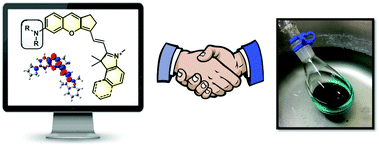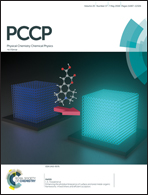Rationalisation of the optical signatures of nor-dihydroxanthene-hemicyanine fused near-infrared fluorophores by first-principle tools†
Abstract
Using a computational approach combining the Time-Dependent Density Functional Theory (TD-DFT) and the second-order Coupled Cluster (CC2) approaches, we investigate the spectral properties of a large panel of nor-dihydroxanthene (DHX)-hemicyanine fused dyes. First we compare the theoretical and experimental 0–0 energies for a set of 14 known synthetic compounds and show that a remarkable agreement between theory and experiment is obtained when a suitable environmental model is selected. In addition, we obtain vibrationally-resolved spectra for several compounds and theory also accurately reproduces the experimental band shapes. We show that the electronic transitions in nor-DHX-based fluorophores are associated with small variations of the dipole moments but large oscillator strengths. Using various chemical strategies, we design a series of compounds with red-shifted 0–0 energies.



 Please wait while we load your content...
Please wait while we load your content...